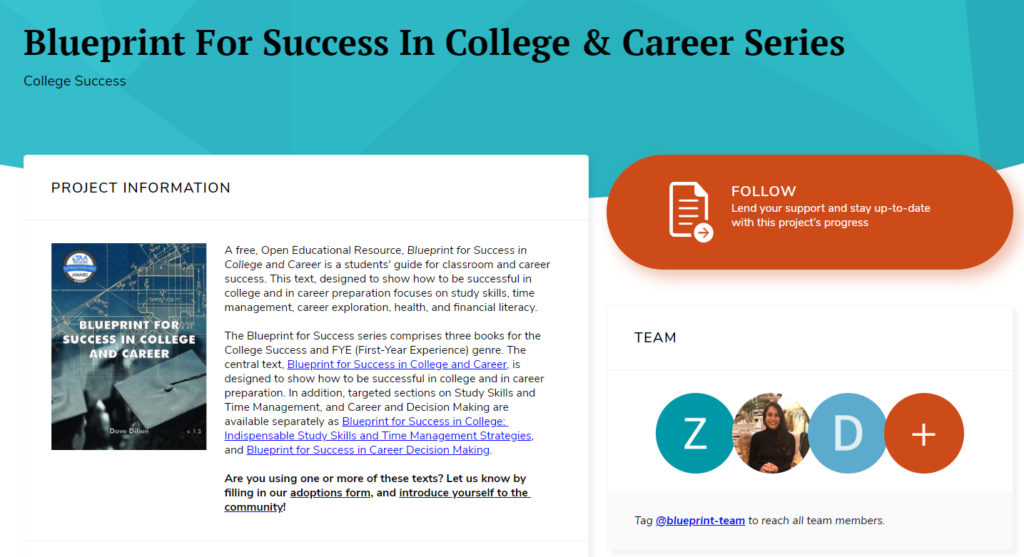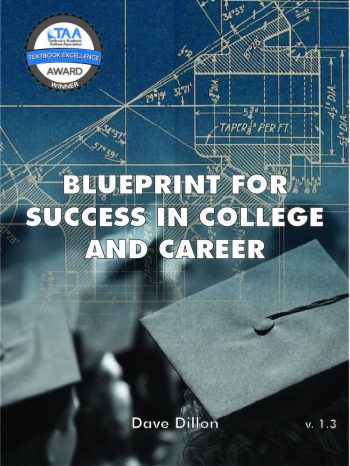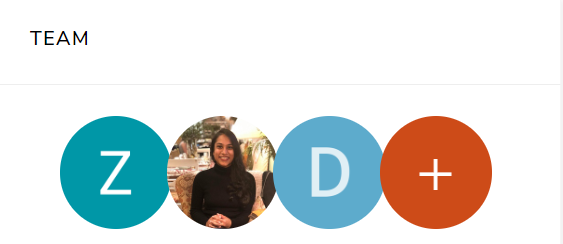This is the ninth in a series of reports filed by Donna Langille, a practicum student who joined us for the spring of 2019. We’ll be releasing each chapter as a weekly blog post. Find the complete text at Rebus Community Reports.

A Man, a Plan, and Lots of Fans
Dave Dillon’s Success Story
Like many major project plans, Dave Dillon’s Blueprint for Success in College and Career has seen a number of iterations along its lifeline. Today, Blueprint for Success is itself a striking triumph, with multiple adopters and users, and a great deal of value delivered to innumerable students. The idea for the textbook emerged out of a spectrum of needs—those of both teachers and learners, as well as the author’s own desire for a highly functional text. In early 2019, it won a Textbook Excellence Award from the Textbook & Academic Authors Association, and the accolades continue to flow in, including an Open Textbook Award for Excellence from the Open Education Consortium.
Back in 2005, Dave was working as an adjunct counsellor and instructor at five different community colleges in four different districts in Southern California. Working at multiple institutions made choosing a textbook complicated. Students had different needs, bureaucracies had different procedures. He began thinking that, once he became full-time, he would just write his own textbook. With the diversity of his teaching and counselling experience, he had a very clear idea about the kinds of learning materials that he wanted for his students.
At the time, Dave wasn’t particularly familiar with the concept of openness, but he was starting to feel the needs that openly published textbooks fill so well. He knew he wanted control over the educational content he included in his lessons, and he knew a lot of that content existed in the world in different publications and formats. He also knew that the student experience is constantly changing, and that, over time, whatever he put together would need to be adapted and revised. Two years after reaching the conclusion that he was eventually going to create his own textbook, Dave became a full-time faculty member at Grossmont College in El Cajon, California. And so began his plan to start construction on Blueprint.

It wouldn’t be until 2009 that Dave actually got going, however, focusing on creating a textbook for a one-unit study skills and time management course. He gave himself two years to make it happen. In all, it took five years and was, as he describes it, “a wonderful learning process” about all the things that go into putting a book together.
A couple of national publishing offers came in, but Dave wasn’t confident about the attention and promotion that his book would receive. In the end, somewhat by accident, he discovered Montezuma Publishing, on the San Diego State University campus, located not far from his home institution. They did the formatting and printing, although Dave had to pay for his own editor. They negotiated a price of $29.00 for the 100-page-book, and it was published in 2014.
Overall, Dave was happy with this experience, and in particular that the book would be more affordable for students. In his work as a counsellor, Dave had already witnessed first-hand how the high prices of textbooks—as well as problems with distribution and availability—frequently have a negative impact on student lives and learning. He recalls one particular student who admitted that they couldn’t afford all their textbooks. Instead, they decided to drop certain classes and re-register in others—those for which the instructor had selected a cheaper textbook. In this case, the student was also living with homelessness. Dave knew that situations like this existed, but it wasn’t until the student was in his office, recounting the painful details of that cold truth, that it really hit him. Suddenly the connections between affordability, customized content, learning outcomes, and holistic student success all came together. It was a powerful moment.
Dave was already familiar with the term open educational resources, as well as the potential that OER offer in terms of meeting both student and teacher needs. However, like many others who are new to the concept and processes of making OER, he had a lot of questions. How does the quality of open educational resources stack up to conventionally published books? Are they accessible to everyone, and if so, how is this achieved? Are they more or less sustainable than other textbooks? Are they academically rigorous enough? If he were to produce one, would it stand up to the scrutiny of his peers and, importantly, his students?
Over time, as he sought the answers to these questions, Dave discovered other issues related to conventional publishing, specifically about availability. For a number of semesters, students had been telling Dave that they couldn’t buy his textbook in the bookstore because it wasn’t there. It seemed unlikely to him at first, but after hearing about this issue from multiple students in different courses, he decided to investigate. He visited the bookstore at several intervals before and after his course had begun. True enough, he was surprised to discover that the bookstore didn’t have the book in stock at different points in the semester. Common bookstore practice is to understock textbooks, in order to save money by not having to carry the cost of inventory. Clearly, however, this causes real problems for students, especially for those with cash-flow problems: if you have to wait for loan disbursements or a monthly pay check, you can’t always come up with the cash when a book is in stock. Moreover, if you have to wait to purchase your textbook, you might find yourself weeks into the start of the semester, already behind in your readings. If you have to have the bookstore order the textbook from the publisher, the delay can also be substantial. Dave really wanted to do something to prevent this from happening to his students, and the solution seemed to be to create an open textbook.
Dave’s first move was to look for open content on successfully navigating the college experience. He knew that a lot already existed, and that he could keep all the material openly licensed, using the CC-BY attribution. One text that he found and wanted to use, however, had been licensed share-alike non-commercial by the authors. He decided to contact them and ask if they would consider a license change. Because of the intent with which he was undertaking this new project, the authors agreed to the change, and Dave was able to include the material in his new book. He also had the same ‘conversation’ with himself, and re-licensed chapters from his previous textbook as CC-BY, which he then incorporated into the new OER. (Fortunately, the original publisher, Montezuma, had allowed Dave to retain his own copyright on the content.)
Much editorial and revision work ensued, including the peer-review process for the ‘finished’ work. Dave admits that it was an anxiety-inducing period, but in the end, most of the reviewers’ feedback was overwhelmingly positive. The critiques made the content better, and quite a few errors were identified and fixed through these reviews. The overwhelming feeling, after all the work, was gratitude for all those who had volunteered to look at the book with both an open mind and a sharp eye.
Dave went on to pilot the book in class, prior to ‘official’ publication. Again, the response was great, and a few more revisions followed. Having been made available online, for free, and in time for the start of the semester, the textbook went on to receive cheers from students, and positive word of mouth started to spread. Since its release, Dave has heard from numerous instructors who are adopting it for their own classroom use.

As happens with many open textbooks, the popularity of Blueprint for Success has prompted interest in ancillary materials. Though Dave had not anticipated such an excited reception, or the need to create more content so quickly, he had has ancillaries in mind along the way. His colleague Roico Terry has created a set of PowerPoint slides, and quiz banks have been developed that support the textbook’s learning outcomes. Dave has also released a new version of Blueprint for Success, augmented with a cultural competency chapter that was developed in collaboration with Stanford University’s Global Studies Division. The team is also working on an audio version, led by Lee Pierce, an assistant professor of rhetoric in the Communication Department at SUNY Geneseo. Narration for the audio is being recorded by SUNY students.
To date, the book has been adopted at thirteen California community colleges, and is being used in at least one school in Oregon, New Jersey, New Hampshire, and Tennessee. Another institution in Michigan is in the process of adapting the textbook, and the New Jersey–based instructor has already created their own adaption.
Blueprint for Success has become, in many ways, a blueprint in itself. Dave Dillon’s experience was one that started with a combination of needs that weren’t being met by the publishing processes he already knew about. By looking for alternatives, asking for help, and not trying to reinvent the wheel, he did in fact reach an innovative outcome. Moreover, through this success, Dave has demonstrated another example of how publishing can be truly a community-based process. In his own words: “There are other faculty out there recognizing and looking for solutions to the same challenges. It is well worth spending the time to try to identify them and collaborate with them. There is no need to go it alone. I’m hopeful that the open community continues to evolve, and that there are more collaborative opportunities for people. I think people are really willing to volunteer in an altruistic way when there’s not a ‘publisher’ (or sometimes an author) who’s making a profit off of the book.”

Images from the new Rebus Community project homepage have been included in this post. To view the complete project homepage for Blueprint for Success in College & Career visit Rebus.Community. Create a project homepage for your open textbook in development by logging on to Rebus.Community and clicking “Create a Project.”
